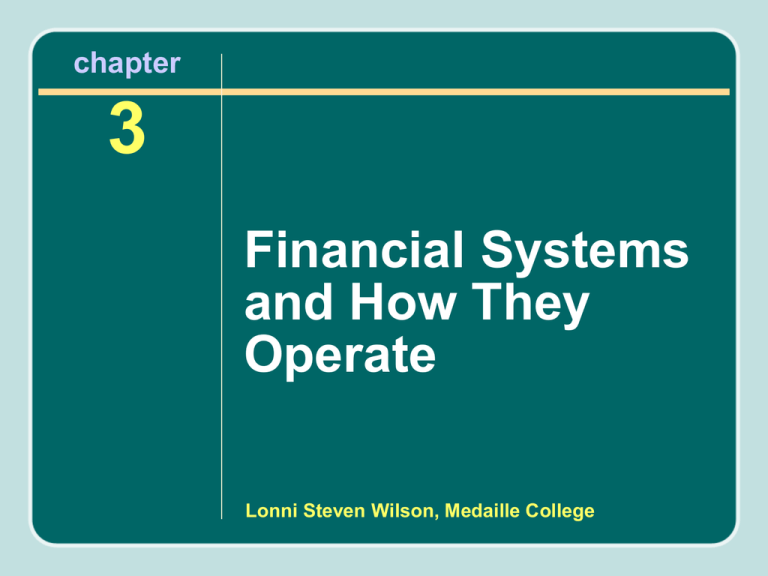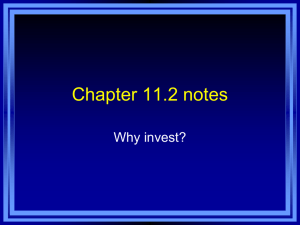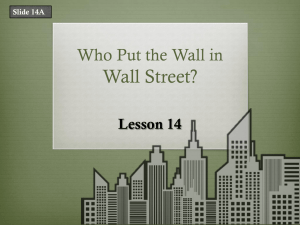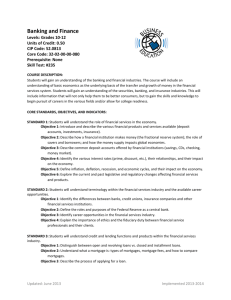chapter 3 - Human Kinetics
advertisement

chapter 3 Financial Systems and How They Operate Lonni Steven Wilson, Medaille College Key Chapter Objectives • Describe what a financial market is. • Compare the different types of financial markets and how they affect sport. • Understand the differences among marketable securities such as stocks and bonds. • Explain how a sport business can acquire needed capital. Types of Financial Markets • • • • • • • • • • Tangible or physical markets Financial asset markets Spot markets Money markets Mortgage markets Primary markets Futures markets Capital markets International markets Secondary markets Funding through Financial Markets • Businesses are not required to use only one market exclusively. • Most businesses utilize several different markets when raising capital. • No matter what market is used, the key to funding business growth and facilitating movement within all financial markets is . . . money. Money • Money is the means by which commerce can occur. • Money has no value in and of itself; it’s just metal or paper. • There is agreement between two parties that it has value (i.e., value is arbitrarily placed). Instruments of Commerce • • • • Money Credit Checks Marketable securities (representing documentation of ownership or indebtedness, such as stocks and bonds) Key Terms hard assets—Assets that a company might not be able to convert to cash quickly but that still have significant value (e.g., a factory building, real estate, machinery). liquid assets—Assets that are able to be moved relatively quickly. Marketable Securities Marketable securities are instruments so widely accepted and purchased by others that they are very similar to cash (Brigham & Ehrhardt, 2005). Examples include the following: • • • • • T-bills T-notes Government agency securities Certificates of deposit Commercial paper The Most Liquid of Assets Marketable securities are the most liquid. • Shorter maturity periods (T-bills) • Ability to sell on a daily basis (stocks) • Relatively risk free (certain bonds and government securities) Securities from Risk Free to High Risk Refer to table 3.1 in the text. Risk-free and lower-risk securities include the following: • U.S. Treasury bills • Commercial paper Higher-risk securities include the following: • Corporate bonds • Common stocks Stocks: Bear versus Bull Market A stock certificate is a document demonstrating ownership interest in a company. Bear market • A bear market is a prolonged period during which stock prices continue to decline. Bear markets can be caused by poor economic conditions, political collapses, rising interest rates, or a host of other factors that foster pessimism among investors. • A bear is an individual who believes that the stock market will drop (typically more than 20%) and sells stocks, “goes short,” or buys a put. Bull market • A bull market occurs when there are prolonged market advances over a significant time period. • A bull is an investor who has a favorable outlook on the economy and is willing to invest in stock, bonds, and other securities. Key Terms debtor—Entity issuing the bond. creditor—Entity purchasing the bond. Bonds The greater a company’s financial strength, the easier it is for the company to issue bonds. Bonds are infrequently seen in the sport industry, but examples do exist: • The New York Yankees and the New Jersey Nets merged and undertook a bond offering through YankeeNets LLC that raised $250 million. • Proceeds were used to help purchase the New Jersey Devils. Types of Financial Institutions • Banks • Stock exchanges Banks Besides providing loans and facilitating economic growth by making money available to borrowers, banks perform various additional services. These services include • allowing individuals to deposit their money in a bank account for safekeeping, • allowing checking account holders to write checks demanding that the bank pay another party a specific amount, • providing clients with cashier’s checks or certified checks when necessary, • providing numerous specialty savings accounts for customers, and • acting as general depositaries for U.S. Treasury funds. Stock Exchanges Stock exchanges are owned and operated by their members. There are three major U.S. stock exchanges: • New York Stock Exchange (NYSE) • National Association of Securities Dealers Automated Quotations (NASDAQ) • American Stock Exchange (AMEX) NYSE The premier U.S. stock exchange is the New York Stock Exchange (NYSE). • Private entity, founded in 1792 (3,000 companies) • Average of 1.08 billion shares traded daily • To be a member – 2,000 shareholders – market value of $100 million (minimum) – profitable for the last three years, with earnings of at least $6.5 million each of those years NASDAQ National Association of Securities Dealers Automated Quotations (NASDAQ) • Computerized trading system for more than 3,300 publicly traded companies • Image exists that its companies are more cutting edge (many start-ups, high-techs launched here) • Primary U.S. market for trading securities in overseas companies • Founded in 1971 • Average of 1.76 billion shares traded daily AMEX and Other Exchanges American Stock Exchange (AMEX) • 700-plus small- to midsized businesses • Large number servicing the oil industry Smaller regional exchanges exist in the United States (e.g., Boston, Cincinnati, Chicago, Pacific, Philadelphia stock exchanges). Specialty exchanges also exist. Buying and Selling on Stock Exchanges The ask (or offer) price is the price that a seller would like to receive for the item he or she wishes to sell. The bid price is the price that a potential buyer is willing to spend to acquire the item. Somewhere between these, a compromise is reached (similar to eBay). • NYSE and AMEX – auction style with a floor • NASDAQ – buying and selling negotiated through computers Questions for In-Class Discussion 1. What is the difference between the NYSE and the NASDAQ? 2. What determines value? 3. What is the difference between stocks and bonds? 4. Should governments control banks? 5. Discuss some of your positive and negative banking experiences, such as bouncing a check.





